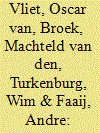| Srl | Item |
| 1 |
ID:
101398


|
|
|
|
|
| Publication |
2011.
|
| Summary/Abstract |
We examined the co-evolution of the transportation, and electricity and heat generation sectors in the Netherlands until 2040 using a MARKAL bottom-up cost optimisation model.
All scenario variants investigated indicate a switch away from crude oil-based diesel and petrol for transportation. Lowest overall CO2 abatement cost is achieved by accommodating transportation first and using relatively expensive options for emissions reduction in electricity generation if needed.
Biomass and carbon capture and storage (CCS) are used to full potential. Transportation CO2 emissions are reduced by switching to ethanol or bio-based synthetic fuels combined with CCS, and series hybrid cars if needed. Depending on the availability of biomass and carbon storage capacity, electricity is produced from biomass, coal with CCS, or wind complemented with natural gas. Indirect greenhouse gas emissions rise to 34-54% of national emissions in 2040.
The difference in annual investment required between the scenario variants with and without CO2 emissions reductions of 68% by 2040 is 4-7 billion euro/year, or 0.5-1.2% of projected GDP.
Investment costs are mostly determined by the cost of cars and electricity generation capacity. We observe competition for limited biomass supply and CO2 storage capacity between the transportation and power sectors.
|
|
|
|
|
|
|
|
|
|
|
|
|
|
|
|
| 2 |
ID:
125461


|
|
|
|
|
| Publication |
2013.
|
| Summary/Abstract |
Biomass is considered one of the most important options in the transition to a sustainable energy system with reduced greenhouse gas (GHG) emissions and increased security of enegry supply. In order to facilitate this transition with targeted policies and implementation strategies, it is of vital importance to understand the economic benefits, uncertainties and risks of this transition. This article presents a quantification of the economic impacts on value added, employment shares and the trade balance as well as required biomass and avoided primary energy and greenhouse gases related to large scale biomass deployment on a country level (the Netherlands) for different future scenarios to 2030. This is done by using the macro-economic computable general equilibrium (CGE) model LEITAP, capable of quantifying direct and indirect effects of a bio-based economy combined with a spread sheet tool to address underlying technological details. Although the combined approach has limitations, the results of the projections show that substitution of fossil energy carriers by biomass, could have positive economic effects, as well as reducing GHG emissions and fossil energy requirement. Key factors to achieve these targets are enhanced technological development and the import of sustainable biomass resources to the Netherlands.
|
|
|
|
|
|
|
|
|
|
|
|
|
|
|
|